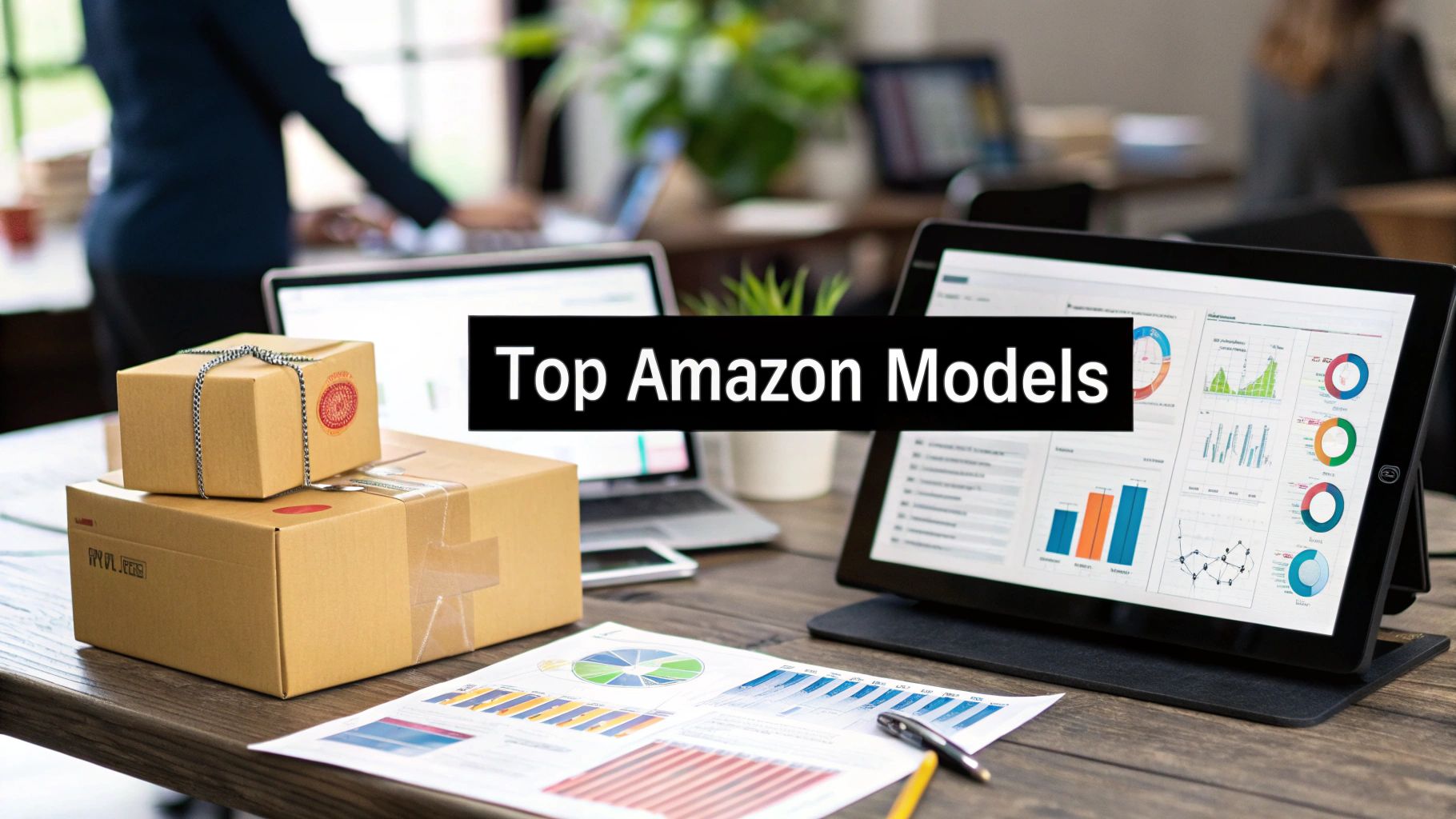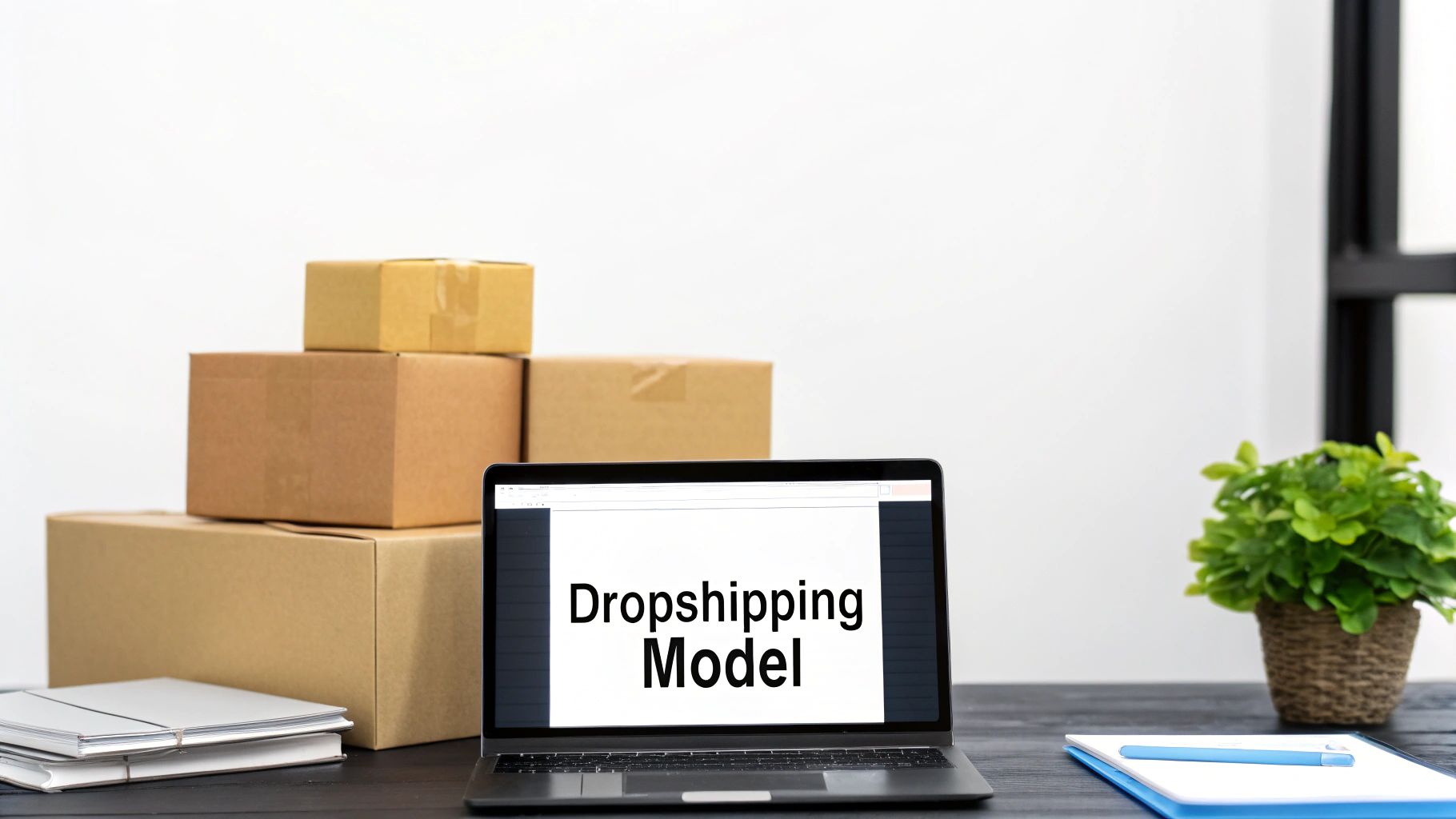Stay Updated with Everything about MDS
Thank you! Your submission has been received!
Oops! Something went wrong while submitting the form.

Chilat Doina
August 9, 2025
Amazon remains a titan of e-commerce, but success on the platform is not one-size-fits-all. The foundation of any thriving Amazon enterprise is a well-chosen strategy, as the 'best' approach depends entirely on your capital, risk tolerance, time commitment, and long-term goals. Navigating the various business models Amazon offers is the first critical step toward building a sustainable and profitable venture.
This guide moves beyond surface-level advice to provide a strategic breakdown of the primary ways to sell on the platform. We will dissect each model's operational reality, from initial investment and sourcing to daily management and scaling potential. Before diving into the more niche strategies, it is beneficial to explore the 4 most popular ways to sell on Amazon to establish a baseline understanding.
We will provide an in-depth analysis to help entrepreneurs and brand managers make informed decisions. Whether you aim to build a global brand with a private label, capitalize on market inefficiencies with arbitrage, or sell directly as a wholesaler, understanding these distinct pathways is essential. This breakdown delivers the clarity needed to select the right model and confidently scale your e-commerce business.
The Amazon Private Label model is arguably one of the most popular and scalable business models Amazon sellers pursue. It involves identifying a high-demand product with room for improvement, sourcing a generic version from a manufacturer (often overseas), and then creating your own unique brand, logo, and packaging to sell it as a new, distinct item exclusively on the Amazon marketplace.

This model is not about reselling; it's about brand building. Successful private label sellers, like the popular kitchen brand Instant Pot or the electronics accessory company RAVPower, built their empires by finding gaps in the market and launching products with superior features, better branding, or more effective marketing.
Private label is ideal for entrepreneurs who want to build a long-term, defensible asset. If you have a vision for a brand and are willing to invest upfront capital in inventory, branding, and marketing, this model offers the highest potential for profit margins and brand equity. It's a strategic choice for those aiming to create a sellable business, not just a side income stream.
The Amazon Private Label model is arguably one of the most popular and scalable business models Amazon sellers pursue. It involves identifying a high-demand product with room for improvement, sourcing a generic version from a manufacturer (often overseas), and then creating your own unique brand, logo, and packaging to sell it as a new, distinct item exclusively on the Amazon marketplace.

This model is not about reselling; it's about brand building. Successful private label sellers, like the popular kitchen brand Instant Pot or the electronics accessory company RAVPower, built their empires by finding gaps in the market and launching products with superior features, better branding, or more effective marketing.
Private label is ideal for entrepreneurs who want to build a long-term, defensible asset. If you have a vision for a brand and are willing to invest upfront capital in inventory, branding, and marketing, this model offers the highest potential for profit margins and brand equity. It's a strategic choice for those aiming to create a sellable business, not just a side income stream.
The Amazon Affiliate Marketing model, officially known as Amazon Associates, is a performance-based approach where you earn a commission by driving traffic to Amazon. Instead of selling products yourself, you act as a publisher, creating content that recommends products and embedding special tracking links. When a reader clicks your link and makes a purchase on Amazon within a 24-hour window, you earn a percentage of the total sale.
This is one of the oldest and most accessible business models Amazon offers, requiring no inventory, shipping, or customer service. Success stories like Wirecutter (now owned by The New York Times) and countless niche blogs demonstrate the power of building an audience around helpful, product-focused content. The model thrives on trust and authority, converting expert recommendations into passive income.
This model is perfect for content creators, bloggers, YouTubers, and niche site builders who enjoy researching and reviewing products. If you have expertise in a specific area, from home coffee brewing to high-end electronics, and can create high-quality content that helps people make buying decisions, this is an excellent low-risk entry point into the Amazon ecosystem. It’s ideal for those who prefer building a media asset over a logistics-heavy e-commerce operation.
The Amazon Wholesale model is a time-tested approach to e-commerce that involves buying branded products in bulk directly from the manufacturer or an authorized distributor at a wholesale price. You then resell these same products on Amazon for a retail profit. Unlike private label, this model focuses on selling existing, well-known brands that already have established demand and customer recognition.
This model is less about brand creation and more about supply chain management and capitalizing on existing market dynamics. Successful wholesalers, like those taught by Dan Meadors and Dylan Frost of The Wholesale Formula, excel at building relationships with suppliers and finding products with healthy profit margins and manageable competition on the Buy Box.
Wholesale is an excellent fit for entrepreneurs who are analytical, process-driven, and prefer dealing with established products rather than building a brand from scratch. If you are good at negotiation, building B2B relationships, and managing inventory logistics, this model can provide a steady and scalable income. It’s a great middle-ground between the high risk of private label and the low margins of arbitrage.
The Amazon Dropshipping model is a retail fulfillment method where sellers list products on Amazon without holding any physical inventory. When a customer places an order, the seller purchases the item from a third-party supplier, who then ships it directly to the customer. This model positions the seller as a middleman, capitalizing on price differences while eliminating the need for inventory management and upfront capital investment.

This approach lowers the barrier to entry for e-commerce, as popularized by platforms like Oberlo and communities surrounding AliExpress. Sellers can offer a wide variety of products, such as electronics accessories or home decor items, sourced from global or domestic suppliers without the financial risk of buying stock in advance. The key to success is finding reliable suppliers and products with sufficient profit margins.
Dropshipping is best suited for entrepreneurs who want to test the e-commerce waters with minimal financial risk. It's an excellent choice for those skilled in marketing and customer service but who lack the capital or warehouse space for inventory. It's also a viable strategy for testing product-market fit before committing to a larger order for a private label or wholesale business.
The Amazon Retail Arbitrage model is one of the most accessible business models Amazon offers, serving as a popular entry point for new sellers. It involves purchasing discounted products from traditional retail stores, like Walmart or Target, and reselling them on the Amazon platform for a profit. The core principle is to capitalize on price discrepancies between what a product costs on a local clearance rack and what a customer is willing to pay for it on Amazon.
This model is pure hustle, turning shopping into a treasure hunt. Influential figures like Jim Cockrum of Silent Sales Machine and Reezy Resells have built huge communities around teaching people how to find profitable items hiding in plain sight. Success stories often involve sellers finding discontinued toys after the holidays or seasonal items in the off-season and selling them for a significant markup.
Retail arbitrage is perfect for individuals looking for a low-risk, low-startup-cost way to begin selling on Amazon. It requires minimal initial capital since you can start with just a few items. This model is ideal for those who enjoy the "thrill of the hunt," are detail-oriented, and want to learn the fundamentals of the Amazon ecosystem without committing to creating a brand or purchasing large quantities of inventory.
The Amazon Handmade Artisan model is a niche and highly specialized platform within the Amazon ecosystem, created specifically for artisans to sell their handcrafted goods. Unlike the mass-market nature of other business models amazon offers, Handmade is an invitation-only marketplace that focuses on genuinely handmade, hand-altered, or assembled products, creating a space similar to Etsy but with access to Amazon's vast customer base and logistics network.
This model is built on authenticity and craftsmanship. Success stories often come from individual creators, such as custom jewelry designers or woodworkers, who turn their passion into a scalable business. It allows makers to connect directly with buyers looking for unique, personalized items that cannot be mass-produced, from bespoke leather wallets to custom-engraved home decor.
This model is exclusively for individual artisans, crafters, and small creative collectives who make their products by hand. If your business is centered around a craft or skill and you want to reach a larger audience without sacrificing the authenticity of your brand, Amazon Handmade is the perfect fit. It is ideal for those whose products tell a story and whose value lies in their uniqueness and craftsmanship, not their low cost.
Shifting from third-party (3P) selling to first-party (1P), the Amazon Vendor Central model represents a fundamentally different relationship with the retail giant. This is a B2B arrangement where you act as a wholesale supplier, selling your products directly to Amazon in bulk. Amazon then owns the inventory and sells it to consumers, managing everything from pricing and shipping to customer service.
This model is invite-only and typically reserved for established manufacturers and distinguished brands. Instead of "Sold by [Your Brand]," customers see the familiar "Ships from and sold by Amazon.com" badge on the product page. Major brands like Sony, Procter & Gamble, and major book publishers use this model to leverage Amazon’s massive retail infrastructure while focusing on their core strengths: manufacturing and supply chain management.
Vendor Central is designed for established brands, manufacturers, and distributors with significant sales volume and a robust, reliable supply chain. If your business is built on large-scale production and you prefer the simplicity of fulfilling large purchase orders rather than managing individual customer sales and marketing, this is one of the most powerful business models Amazon offers. It provides unparalleled credibility and access to exclusive marketing programs.
You've explored the landscape of Amazon business models, from the brand-building power of Private Label to the rapid-entry approach of Retail Arbitrage. We’ve dissected eight distinct paths: FBA, Private Label, Affiliate Marketing, Wholesale, Dropshipping, Retail Arbitrage, Handmade, and Vendor Central. Each one represents not just a way to sell, but a unique strategic commitment with its own set of rules, risks, and rewards.
The critical takeaway is that there is no single "best" model. The optimal choice is deeply personal, contingent on your starting capital, risk tolerance, time commitment, and long-term business aspirations. A recent graduate with minimal funds might find success with arbitrage, while an established brand owner may leverage the Vendor Central (1P) model to scale distribution.
Choosing your model is like selecting a blueprint for a house. The real work begins with the foundation and construction. Success on Amazon is not a passive outcome; it's an active process of relentless execution and optimization. Your chosen business model simply defines the battlefield. Winning requires mastering the specific tactics relevant to that field.
Key Insight: The most successful Amazon entrepreneurs don't just pick one of the business models; they commit to becoming an expert in the specific operational demands that model requires.
Regardless of the path you take, a non-negotiable component of sustainable growth is impeccable financial tracking. Your ability to accurately measure profit margins, track expenses, and manage cash flow will determine your staying power. For a deeper dive into financial best practices, exploring a guide on effective e-commerce accounting can provide the structured approach needed to maintain fiscal health as you scale.
The journey from selecting to scaling one of these business models on Amazon is complex and fraught with challenges unique to the platform. The platform's algorithm changes, competition intensifies, and new operational hurdles constantly emerge. Your initial strategy is your starting point, but adaptation is the key to longevity. The most powerful asset in this dynamic environment is not just information, but a network of trusted peers who are navigating the same challenges. This is where you can transform theoretical knowledge into real-world, high-level execution. Your model is the map, but a network of elite sellers is your ultimate compass and accelerator.
Ready to move beyond the blueprint and connect with entrepreneurs who have mastered these models? The Million Dollar Sellers community is an exclusive, vetted network for elite Amazon sellers to share advanced strategies, overcome complex challenges, and accelerate growth. Join Million Dollar Sellers to tap into a brain trust that can help you navigate the path to seven and eight-figure success.
Join the Ecom Entrepreneur Community for Vetted 7-9 Figure Ecommerce Founders
Learn MoreYou may also like:
Learn more about our special events!
Check Events